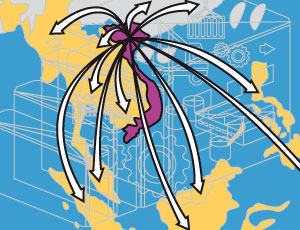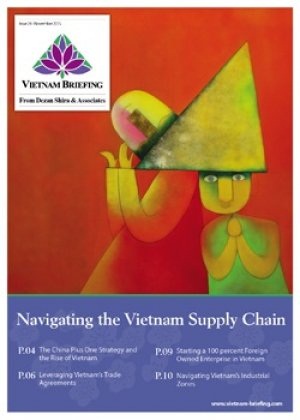The Case for Vietnamese Manufacturing
 By: Dezan Shira & Associates
By: Dezan Shira & Associates
Editor: Constance Holman
With slowing economic growth and rising labor costs encroaching on the profitability of traditional Chinese manufacturing operations, Vietnam has a emerged as a destination of choice for its low costs, receptive governance, and increasing integration with key trading partners. Conjoined, these factors have and will continue to grow Vietnam as a hotbed of manufacturing and position the communist nation as an ideal location for China-plus one oriented production.
In light of recent Free Trade Agreements, notably the Trans-Pacific Partnership and FTA with European Union, Vietnam is well positioned to allow investors to utilize its cheap workforce and close proximity to existing Asian based supply chains.
In recent years, Vietnamese growth has reached record heights, recording a 7.01 percent rate of growth in the fourth quarter of 2015 from a year earlier, according to data released by the General Statistics Office. Driving these gains has been a strong uptake in Foreign Direct Investment (FDI), which surged to a record of US$ 14.5 billion in 2015. According to Nguyen Tan Dung, Prime Minister of Vietnam, these “figures indicate that Vietnam has become a destination of choice for foreign investors”.
 RELATED: Dezan Shira & Associates’ Corporate Establishment Services
RELATED: Dezan Shira & Associates’ Corporate Establishment Services
Vietnam’s Comparative Advantages in the Manufacturing Sector
Among a number of rising sectors in Vietnam, manufacturing distinguishes itself with the largest share of the total investment received. In 2014, FDI projects licensed represented US$ 15.5 billion out of a total amount of US$ 22 billion, that is to say 70.72 percent of new FDI.
This success is sustained by low labor costs and a growing consumer market. The labor force (over 15 years old) amounts to more than 53 million people and remains cheap. In 2015, the average monthly wage in the manufacturing sector was around US$ 190, much lower than Malaysia or China (around US$ 650) and lower than its neighbors Thailand, the Philippines, and Indonesia.
Furthermore, Vietnam benefits from a favorable political environment. The communist government has eased restrictions on foreign investment and is slowly opening its borders. Through incentives, the state has established priority sectors such as manufacturing of high-tech products, research and development, knowledge-based services, processing and manufacturing, and infrastructure projects. It has also created priority geographical regions, with difficult social and economic conditions, and more than 299 industrial zones (IZs) and export processing zones (EPZs) as of July 2015.
Thanks to these competitive advantages, Vietnam has been considered as a reliable substitute to China. Nevertheless, some manufacturing sectors are more vigorous than others.
 RELATED: Vietnamese Labor under TPP: Commitments and Compliance
RELATED: Vietnamese Labor under TPP: Commitments and Compliance
Booming Manufacturing Sectors
Thanks to its central location in Asia and proximity to regional shipping routes, many manufacturers entering Vietnam are export focused. Foreign investors can benefit from many incentives and under many circumstances can be exempt from import duties on goods brought into the country for their own use if they cannot be procured locally. This includes all equipment, machinery, components, and spare parts for machinery and equipment, raw materials, inputs for manufacturing, and construction materials. It should be noted that most export duties are also exempt.
Textile and garment production is a well-known success in Vietnam, and will likely continue to be as it is propelled to new levels by the forthcoming Trans-Pacific Partnership and its reduced tariff barriers. In 2015, the industry provided employment to 2.5 million people working in 6,000 factories, and is expected to grow at a rate of 12-14 percent per year from 2015-2020.
However, Vietnam does not intend to remain stuck in low value-added production. Lately, automotive manufacturers and shipbuilders have also closely considered Vietnam. For instance, Damen, a Dutch shipbuilding firm, opened a new brand, Damen Song Cam, through a joint venture yard in Vietnam. According to their website, this yard should produce 40 ships per year, employing more than 2,500 employees directly and 5,000 indirectly. Moreover, Vietnam has been extremely welcoming towards FDI in electronics, expanding its exports to US $1.6 billion during the first two months of 2016, according to Vietnam Customs. Electronic giants are relocating in Vietnam, evidenced by Intel, Panasonic, and Microsoft.
Challenges
The country is still seen as highly corrupt, ranking 112th out of 177 countries by the Transparency International Corruption Perceptions Index in 2015. Furthermore, the legal environment remains complex, with a slow and bureaucratic government, restrictive labor policies, and land use limitations. Nevertheless, Vietnam keeps on restructuring its decision-making process and introducing more laws favorable to FDI. For instance, it has recently opened its real estate market to foreigners, as well as ironed out some caps in public companies, allowing foreign investors to invest in its promising industries.
|
Asia Briefing Ltd. is a subsidiary of Dezan Shira & Associates. Dezan Shira is a specialist foreign direct investment practice, providing corporate establishment, business advisory, tax advisory and compliance, accounting, payroll, due diligence and financial review services to multinationals investing in China, Hong Kong, India, Vietnam, Singapore and the rest of ASEAN. For further information, please email vietnam@dezshira.com or visit www.dezshira.com. Stay up to date with the latest business and investment trends in Asia by subscribing to our complimentary update service featuring news, commentary and regulatory insight. |
![]()

Annual Audit and Compliance in Vietnam 2016
In this issue of Vietnam Briefing, we address pressing changes to audit procedures in 2016, and provide guidance on how to ensure that compliance tasks are completed in an efficient and effective manner. We highlight the continued convergence of VAS with IFRS, discuss the emergence of e-filing, and provide step-by-step instructions on audit and compliance procedures for Foreign Owned Enterprises (FOEs) as well as Representative Offices (ROs).
 Navigating the Vietnam Supply Chain
Navigating the Vietnam Supply Chain
In this edition of Vietnam Briefing, we discuss the advantages of the Vietnamese market over its regional competition and highlight where and how to implement successful investment projects. We examine tariff reduction schedules within the ACFTA and TPP, highlight considerations with regard to rules of origin, and outline the benefits of investing in Vietnam’s growing economic zones. Finally, we provide expert insight into the issues surrounding the creation of 100 percent Foreign Owned Enterprise in Vietnam.
 Tax, Accounting and Audit in Vietnam 2016 (2nd Edition)
Tax, Accounting and Audit in Vietnam 2016 (2nd Edition)
This edition of Tax, Accounting, and Audit in Vietnam, updated for 2016, offers a comprehensive overview of the major taxes foreign investors are likely to encounter when establishing or operating a business in Vietnam, as well as other tax-relevant obligations. This concise, detailed, yet pragmatic guide is ideal for CFOs, compliance officers and heads of accounting who must navigate Vietnam’s complex tax and accounting landscape in order to effectively manage and strategically plan their Vietnam operations.
- Previous Article Vietnamese Labor Under TPP: A Guide to Commitments and Compliance
- Next Article Vietnam Regulatory Brief: Life Insurance, Relaxing Airport Restrictions, and New Classification for Securities Trading in Vietnam









